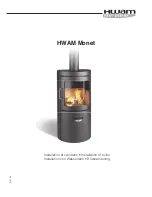
Triton
│
Installation and Operation Instructions - Boiler Assembly
VS80-130
8
Burner Installation
The Triton boiler is designed to work with burners described in this manual. The use of other nozzles, and/or
burners, may cause unsafe operation and will void any and all responsibility by NY Thermal for the safety and
reliability of the system.
The burner kit should be installed in accordance with the instructions in this manual and the burner
manufacturer’s instructions included with the burner. Refer to specification Tables 2-1 to 2-4 for nozzle sizes,
burner settings, insertion depths, and air setting guidelines.
Ceramic Fiber Materials
- Before installing the burner, read “Handling Instructions” in
Section 9.0 and the protective measures recommended when handling ceramic materials.
Fuel Oil
- Triton boilers operate with No. 2 oil as their only approved fuel source. DO
NOT USE GASOLINE, CRANKCASE DRAININGS, OR ANY OIL CONTAINING
GASOLINE. Failure to follow these instructions may result in severe personal injury,
property damage, or death.
Combustion Analyzer
-
To calibrate burner operation, use a calibrated combustion analyzer
capable of measuring CO
2
and O
2
from oil burning boilers
Smoke Test
- All tests must be done with the burner covers or air intakes in place to
simulate normal operation.
Smoke Pump
- A reliable, certified smoke pump is required to correctly set up this
equipment.
Avoid Condensation
- Due to the high combustion efficiencies and low stack gas
temperatures, great care must be taken to ensure the chimney isn’t subjected to flue gas
condensation. The gas temperature where the flue pipe enters the chimney must be a
minimum of 240
o
F.
Burner Installation Procedure:
a.
Prepare the burner in accordance with the burner manufacturers instructions included with the burner.
b.
Refer to specification Tables 2-1 to 2-4 to determine the appropriate nozzle size for the boiler output. See
“Attention: Nozzle Sizes” in Section 2.0.
c.
Riello Burners (extra step required): Mount the burner gasket and burner flange to the boiler. Secure to
the boiler using washers and nuts provided (Figure 4-5). Seal around the burner gasket and the blast tube
ring with high temperature silicone (i.e. 83ml tube of silicone included in the burner kit).
d.
Mount prepared burner package to the boiler. Seal around burner flange with high temperature silicone.
Combustion Air Settings
- Refer to Section 8.0 Installation Checklist for instruction
regarding adjusting combustion air settings.
Oil Supply Tank and Oil Piping
The oil supply tank and piping should be installed in accordance with the instructions in this manual; the burner
and pump manufacturer’s instructions; National codes NFPA 31 (USA) or CSA B139 (Canada), and local codes.
General Installation Guidelines:
1.
Install the oil supply tank as per tank manufacturer’s instructions.
2.
Install oil supply piping from the tank to the burner.
3.
Recommend installing a low pressure-drop fuel oil filter to prevent burner nozzles plugging at low flow rates.
4.
Shut-off valves should be installed to control the flow during operation and to avoid spills during servicing.
5.
Oil can be fed from the supply tank by gravity (single pipe system) or by transfer pump (two-pipe lift system).
6.
Refer to burner manufacturer’s instructions before installing oil piping systems as some burner packages are
not equipped to work with two-pipe lift systems (i.e. Riello BF5).
7.
Connect oil supply piping to the fuel oil pump as per the pump manufacturer’s instructions and system type.
Pipe Dope / Teflon Tape
- DO NOT use on direct oil connection to the fuel pump.
Failure to follow instructions may cause valve failure and dangerous operating conditions.









































